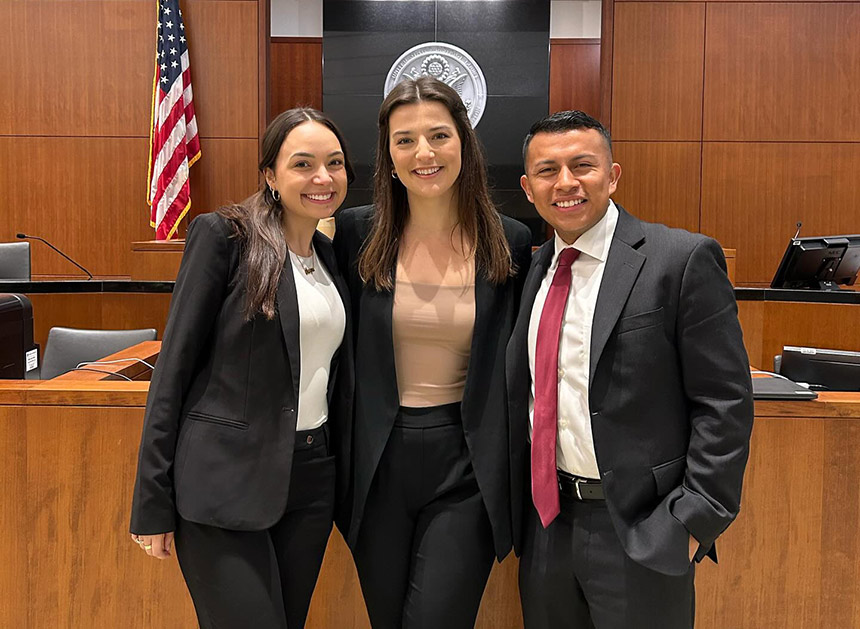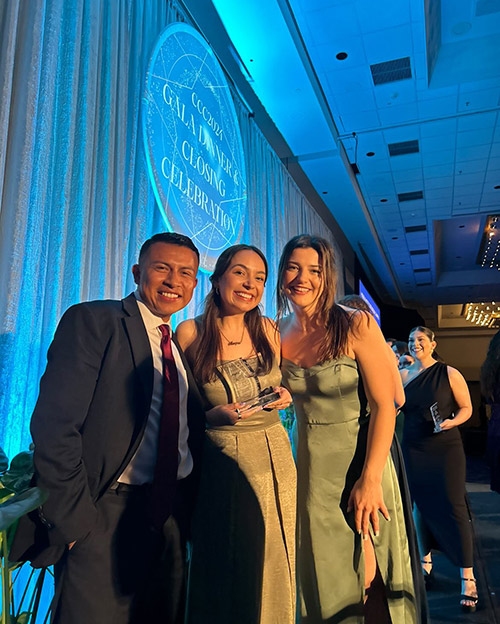
By Gwyneth K. Shaw
A self-coached trio of Berkeley Law students recently won the Hispanic National Bar Association’s (HNBA) Uvaldo Herrera National Moot Court Competition, topping a field of 32 teams to snag scholarship money along with bragging rights.
3Ls Adriana Hardwicke and Maripau Paz decided to team up late last fall after Hardwicke found information about the contest, held annually during the association’s annual convention. Hardwicke had competed on the law school’s Moot Court Team, but Paz had chosen the Trial Team route instead.
“It was an opportunity to try a skill, and of course to work with Adriana,” Paz says. “We had worked together during our 1L year on a mock trial competition, so I thought it would be really cool if we ended our 3L year doing a moot court one together.”
José Rodriguez, a Harvard Law exchange student, did Harvard’s Ames Moot Court Competition and says he jumped at the chance to join the team.
“The possibility of winning a scholarship was the thing that really made me want to do it,” he says. “Also, I was still trying to figure out what I really wanted to do between trial work and appellate work. Competing in the HNBA competition made me realize that I wanted to do more appellate work, so now I’m gearing myself toward smaller boutique firms that do more of that work.”
Because the group wasn’t working through the school’s Advocacy Competitions Program, they had to raise money for the entry fee and travel to Seattle for the event. The Student Association at Berkeley Law and the La Alianza Law Students Association agreed to help sponsor them, and Dean Erwin Chemerinsky topped off the funding.
Then it was time to turn their attention to the contest itself, which began with a January 31 brief deadline. The problem to be argued — concerning the constitutionality of one federal firearms statute under the U.S. Supreme Court’s decision in N.Y. State Rifle & Pistol Association, Inc. v. Bruen

and the applicability of another to the person indicted and convicted — was released while Paz, Hardwicke, and Rodriguez were still taking exams from the fall semester. Writing the brief for the respondent’s side absorbed much of January.
Then the moots began: At least two each week, with everyone from classmates to Criminal Law & Justice Center Executive Director Chesa Boudin and various professors listening to their arguments, asking questions, and poking holes in their reasoning. It was an intense time, the students say — but it gave them a big advantage.
“The unique thing about us that I’m really proud of is the fact that we didn’t have a coach. Out of all of the HNBA teams that made it to quarterfinals, all of them had someone that was leading them or telling them if it was good or not,” Paz says. “It was a lot of teamwork, but we also made up for not having a coach with a really intense mooting schedule. People really came together to help us.
“By the time we got to the competition we had done almost 30 moots, and we felt it wasn’t our first time getting questions. I think that made us way more comfortable and ultimately more successful.”
The contest itself was also grueling, with multiple arguments over the first two days followed by the final on the third — a big difference, Hardwicke says, from the moot court competitions she’d done before.
“It was just as much of a learning experience for all of us, because we had a lot of rounds of argument in this competition,” she says. “So not only did we have a lot of practice beforehand, I felt like we were getting more practice throughout the competition every time we did it. There was a long road to get to the finals.”
The HNBA competition asks teams to be prepared to argue for either side, further raising the difficulty level.
“We would flip a coin and then we’d get to pick if we won the coin toss whether we argued for the petitioner or the respondent,” Rodriguez says. “Basically every other team, if they won the coin toss, they knew what side they wanted to argue because they knew which side they were better at. But we just wanted to make sure that each of us got an opportunity to argue.”
Each team had access to every other team’s briefs, which also helped the group refine their arguments during their practice sessions.
“It gives you a huge leg up to know every argument the other side could make — you’re just better prepared for your counter arguments,” Hardwicke says.
Hardwicke and Rodriguez argued in the final round, which was livestreamed, allowing their families to watch. All three students were pleased with their performance but nervous.
“Oral advocacy is just very subjective. So you can walk out thinking that you did amazing and not do amazing and you can walk out thinking you did terribly and do better than you thought,” Paz says. “I saw them and I thought they did such an excellent job, so I felt really good about it.
“But you’re never sure until you know for a fact that you’ve won.”
Then there was a final, agonizing hurdle: An hours-long wait for the winners to be announced toward the end of the HNBA’s gala dinner.
“After the oral argument, a friend and I went to watch a movie, because I just wanted to spend three hours not thinking about whether we won or lost,” Rodriguez says. “But it ultimately worked out.”
Paz, Hardwicke, and Rodriguez say they got a lot of nice feedback from lawyers at the event, as well as some of the real-life jurists who judged the competition — a rarity for moot court competitions and a big part of the contest’s appeal, according to the students. Looking forward, they’d like to see it become a tradition for a Berkeley Law team to compete each year — perhaps as part of the school’s formal oral advocacy program, and potentially with one or more of them as a coach.
“Unlike the other mock trial or moot court competitions, this competition didn’t give us any class credit or writing credit, we didn’t have a coach, and we didn’t have set funding, which is OK, because it’s great that we tried it out,” Paz says. “But it would just be really awesome if this competition was seen at the caliber of the other ones and students were compensated for their labor. And it’s a really good look, especially for the Latino community. It was an amazing opportunity to argue with just other HNBA members.
“So I hope it continues, I hope the legacy lives on.”